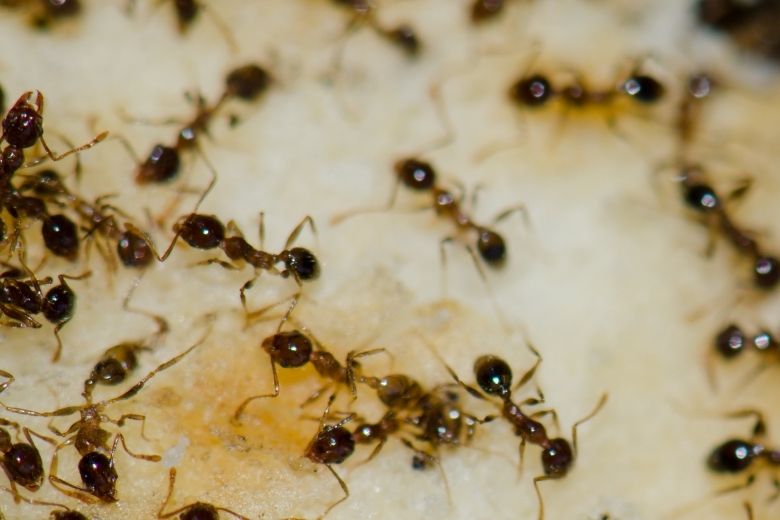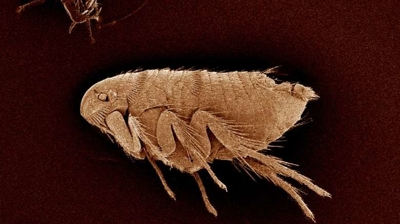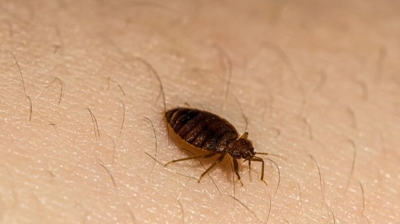
Argentine Ants

Argentine Ants
Argentine ants (Linepithema humile), also sometimes known as sugar ants, are harmful, though not necessarily in the traditional sense of being venomous or directly dangerous to humans. Here are some of the ways they can be harmful:
Human Health
While Argentine ants do not sting and are not directly harmful to human health, they can:
- Bite, though it's mild and generally harmless
- Contaminate food as they forage through kitchens and pantries
- Spread pathogens by crawling over waste and then onto food-prep areas
Learn more: Do Argentine Ants Bite?
Harm to Homes and Structures
- Massive indoor invasions: Argentine ants are highly persistent and often invade homes in large numbers, especially during hot, dry weather or heavy rains. They infiltrate kitchens, bathrooms, electrical outlets, and even inside appliances, creating a major nuisance for homeowners.
- Difficult to eliminate: Due to their supercolony behavior (interconnected nests with multiple queens), Argentine ants are extremely challenging to control with conventional treatments. Spraying often fragments the colony and makes the infestation worse.
Argentine Ant Removal
Argentine ants are considered a significant pest, and it’s crucial to remove them from homes, businesses, and surrounding property for several reasons:
- Rapid Colony Expansion: Argentine ants form massive supercolonies with multiple queens. This allows them to reproduce quickly and dominate new areas, making infestations hard to control once established. A small problem can escalate into a widespread invasion very fast.
- Displacement of Native Species: They aggressively compete with native ants and other insects, disrupting local ecosystems. This ecological imbalance can have cascading effects, including changes in pollination patterns and predation dynamics.
- Structural and Property Concerns: While they don’t cause wood damage like termites, Argentine ants often invade structures in search of food and water, contaminating surfaces and stored products. Their presence in kitchens, pantries, and bathrooms can create hygiene issues.
- Agricultural and Plant Damage: Argentine ants protect and farm sap-feeding insects like aphids and scale insects for honeydew. This relationship encourages pest populations that damage plants, crops, and ornamental vegetation.
- Difficult to Eliminate: Due to their large colonies and mobility, DIY methods are often ineffective. The longer they remain, the more entrenched they become, requiring professional intervention to eradicate.
- Health Concerns: Although they don’t bite or sting aggressively, Argentine ants can contaminate food, spread bacteria, and trigger minor allergic reactions in sensitive individuals.
Their aggressive behavior, ecological impact, and potential for rapid infestation make early detection and our professional removal highly important.
Learn more: How To Get Rid Of Argentine Ants
Argentine Ant Control
Hiring our professional pest control services to deal with Argentine ants is strongly recommended because these ants are notoriously difficult to eliminate due to their behavior, colony structure, and resilience. Here’s why our professional intervention is often necessary:
- Understanding Argentine Ant Behavior: Argentine ants often form “supercolonies” with multiple nests that can span entire neighborhoods. Treating only the visible ants or one nest rarely eliminates the colony. They also quickly relocate nests and adapt to bait or chemical treatments if not applied correctly. Argentine ants will continuously forage for food, meaning that simple DIY sprays often fail to stop the infestation.
- Targeted Baiting Expertise: Our professionals know which baits are most effective for Argentine ants. These baits are designed to be carried back to the colony, ultimately reaching the queen and other nest members. Improper bait use by homeowners can sometimes repel ants rather than attract them, making the problem worse.
- Comprehensive Treatment: Our exterminators identify all nesting sites, which may be outdoors in soil, under rocks, or inside walls. Our professionals utilize Integrated Pest Management techniques, combining sanitation, exclusion (sealing entry points), and chemical treatments for long-term control. Argentine ants generally require ongoing preventative services to ensure re-infestation does not occur.
- Prevention: Our professionals advise on preventive measures such as trimming vegetation away from structures, managing water sources, and proper storage of food. These preventive steps also reduce the likelihood of re-infestation.
- Time and Safety: Handling insecticides improperly can be dangerous for humans and pets. Our exterminators are trained to apply chemicals safely and in the right quantities. Our professional treatments save you time and stress, as Argentine ants can be extremely persistent without expert intervention.
Argentine ants are highly adaptive and form large, difficult-to-eradicate colonies. DIY methods often only provide temporary relief. Hiring our exterminators ensures a strategic, safe, and effective approach that targets the entire colony, not just the ants you see.
Argentine Ant Exterminators
Hiring our local exterminators to tackle Argentine ants provides a strategic advantage that DIY methods usually can’t match:
- Expert Identification and Assessment: Our local exterminators can accurately identify Argentine ants and distinguish them from other ant species. Correct identification is critical because treatment strategies vary by species. We also assess the property to locate nests, trails, and entry points, ensuring the treatment targets the source rather than just the visible ants.
- Tailored Treatment Plans: Our professionals design solutions specifically for Argentine ants, which form supercolonies with multiple queens. Our local expertise allows us to apply baits, insecticides, and barrier treatments in the most effective locations to disrupt the colony’s reproductive cycle. This is far more effective than generic over-the-counter sprays, which often only eliminate worker ants temporarily.
- Use of Safe and Effective Products: Our local exterminators have access to professional-grade products that are stronger and longer-lasting than consumer options but are applied safely around people, pets, and the environment. We also understand optimal timing and dosages for maximum impact.
- Preventive Strategies: Beyond elimination, our local pros provide guidance on reducing conditions that attract Argentine ants, such as moisture management, landscaping adjustments, and sealing entry points. This minimizes the risk of re-infestation.
- Faster and More Complete Eradication: Because Argentine ants can spread quickly across property boundaries and form multiple colonies, our localized, coordinated treatment plans are much more likely to succeed. DIY approaches often leave parts of the colony intact, allowing the infestation to rebound.
- Ongoing Support and Monitoring: Our local exterminators provide ongoing protective visits to monitor ant activity and reapply treatments if needed. This ensures that the colony is fully eradicated and helps protect against future invasions.
- Knowledge of Local Ecology and Climate: Our local professionals understand regional factors that influence Argentine ant behavior, such as seasonal migration patterns, food sources, and typical nesting locations. This insight allows them to intervene at the most effective times and places.
Hiring our local exterminators provides targeted, safe, and efficient elimination, reduces the risk of re-infestation, and saves time and frustration compared to DIY methods. It’s the most reliable way to regain control over Argentine ant problems before they escalate into a serious infestation.
What Do Argentine Ants Look Like?
Argentine ants, Linepithema humile, are relatively small insects, typically measuring between 2 to 3 millimeters in length. Their appearance is uniform, with a light to dark brown coloration. These ants have a segmented body, consisting of three distinct parts: the head, thorax, and abdomen.
The head of an Argentine ant features a pair of segmented antennae, which they use for sensory perception. These antennae are bent and have a noticeable elbow-like joint, which is a key identifying characteristic. The ant's eyes are relatively small and are typically dark in color.
The thorax, located in the middle of their body, is slightly rounded and connects to the head and abdomen. They have six legs attached to the thorax, each with tiny, fine hairs that may be difficult to see without magnification.
The abdomen is the hindmost part of the ant's body and appears smooth and slightly rounded. Unlike some other ant species, Argentine ants lack noticeable spines or bumps on their thorax and abdomen, which can help distinguish them from other ant species.
Where Are Argentine Ants Found?
Argentine ants (Linepithema humile) are found in many parts of the world, far beyond their native range, due to their incredible adaptability and ability to thrive in urban and agricultural environments. Argentine ants prefer:
- Warm to moderate climates
- Moist environments: Mulch beds, irrigation systems, potted plants, under concrete slabs
- Urban and suburban settings: Where water, shelter, and food are abundant
They do not tolerate cold winters well, which is why infestations in cooler climates are usually limited to heated structures like homes, commercial buildings, or greenhouses. Argentine ants are native to South America, specifically Northern Argentina, Uruguay, Paraguay, and Southern Brazil. In their native habitat, natural predators and competitors help keep their populations in check. Their spread has been aided by global trade (especially in plants, soil, and nursery stock), shipping containers, movement of infested landscaping materials, and travel and commerce in port cities. Argentine ants are now found on six continents, primarily in temperate to warm regions, thriving in human-modified environments such as cities, farms, and greenhouses. Their global spread makes them one of the most successful—and problematic—invasive ant species in the world.
Argentine Ant Life Cycle
The life cycle of Argentine ants (Linepithema humile) follows a typical complete metamorphosis—egg, larva, pupa, and adult—but what sets them apart is their colony structure, reproductive strategies, and flexibility, which contribute to their status as one of the world’s most invasive ant species. The full life cycle—from egg to adult—takes about 38 to 74 days under ideal conditions. In colder months or less favorable environments, development slows significantly.
Egg Stage
Fertile queens lay tiny, white, oval eggs. Eggs are non-sticky, smooth, and often grouped together. Under optimal conditions (warmth and moisture), eggs hatch in 12–28 days. The rate of development depends on temperature, humidity, and food availability.
Larval Stage
After hatching, eggs become grub-like larvae. Larvae are legless, soft-bodied, and dependent on worker ants for food and grooming. They are fed by trophallaxis (regurgitated food) from worker ants. This stage lasts about 11–30 days, depending on environmental conditions. Larvae go through several molts before pupation.
Pupal Stage
Argentine ant pupae are naked (not enclosed in cocoons) and resemble adults but are pale and immobile. The pupal stage lasts about 10–25 days. During this time, internal transformation occurs—wings (in reproductive castes), legs, and body segmentation develop.
Adult Stage
There are three castes of adult ants:
- Workers: Sterile, wingless females. Lifespan: Several months. Responsible for foraging, brood care, nest expansion, and colony defense. Workers form massive foraging trails and care for the queen and brood.
- Queens: Fully fertile females, often wingless after mating. Each nest may contain dozens to hundreds of queens. Queens can lay eggs daily (up to several hundred), especially in the presence of abundant food. Lifespan: Several years. Reproduction is continuous, not seasonal, especially in controlled indoor or urban environments. Colonies can have multiple queens (polygyny) and can bud off new nests (colony fragmentation), allowing rapid expansion. This also makes control difficult—killing a few queens or nests often fails to collapse the colony.
- Males: Short-lived and only present during reproductive phases. Their sole function is to mate with queens; they die soon afterward. In Argentine ants, mating occurs within the nest, which differs from many ant species that engage in aerial nuptial flights.
Argentine Ant Supercolonies
Argentine ants form supercolonies, where multiple nests operate as one, without aggression between them. This results in massive populations that stretch across entire neighborhoods, cities, or even regions.
Unlike many ants, Argentine ants rarely use nuptial flights for colony expansion. Instead, they expand through budding, where queens and workers leave the parent colony to form a new satellite nest nearby. This behavior makes them especially successful in urban and suburban environments.

Hear From Our Happy Customers
-
"Fantastic & Patient"
Jarvis was fantastic and patient. He answered my questions with an in-depth explanation and addressed all of my areas of concern. Would love for him to be my assigned tech going forward. Well done!
- Yonnette M. -
"Professional & Considerate"
I’m pleased with Miche services. Jarvis came today. Professional and considerate. Thank you!
- Judy B. -
"Exceeds Expectations"
I can’t say enough positive things about this company... The tech that came out, Jarvis went above and beyond my expectations. Thank you guys, I will continue using your services.
- Jake M. -
"Wonderful Service"
Wonderful service. Jarvis is great. Took care of everything I needed. Thank you!
- Henry P. -
"Great Communication"
Tech was on time, communication was great, and he accommodated my needs.
- Alonzo W. -
"Very Knowledgeable"
The tech that arrived was courteous, professional, and very knowledgeable. He was Great.
- Uerial I.



